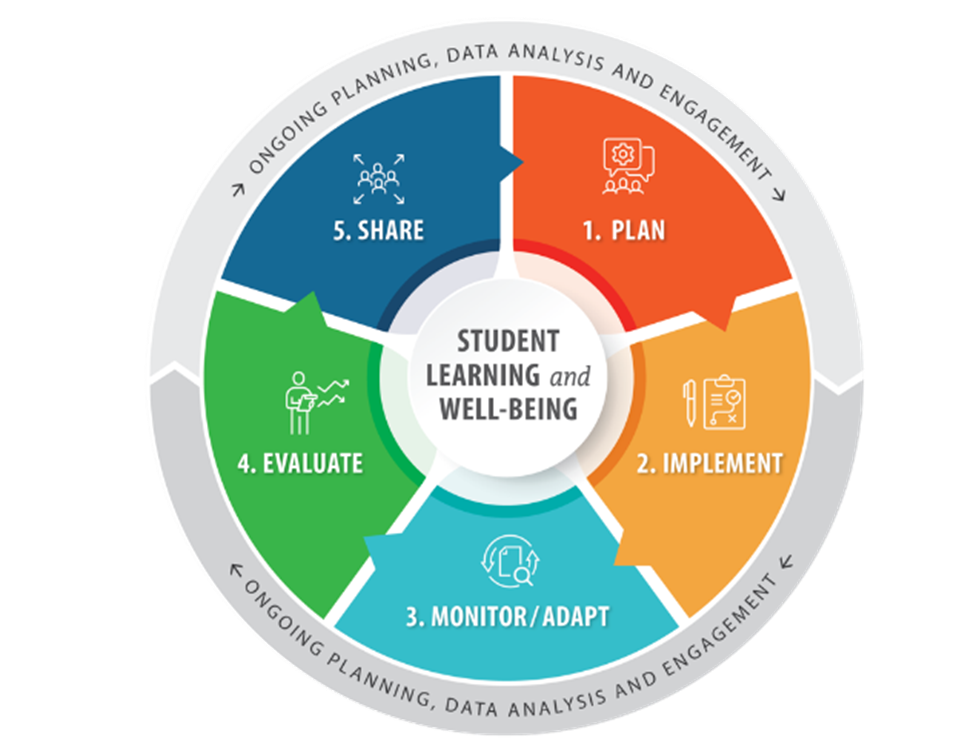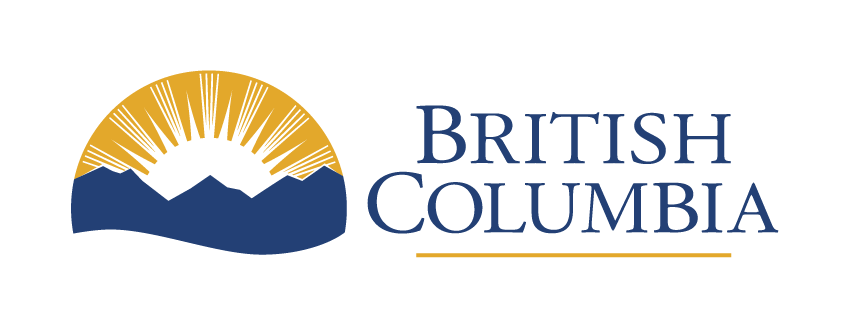Continuous Improvement in Independent Schools Policy
Date came into force or revised
July 1, 2025
Status
Current
Policy statement
BC Independent schools must strive to improve educational outcomes and well-being for students in the schools.
Group 1, 2 and 4 independent school authorities must comply with the Continuous Improvement Plan Order I 1/25 and consider the following areas in their planning for improvement: student literacy, numeracy and well-being. Continuous improvement planning should aim to support equity for all enrolled students.
School planning and data analysis should reflect consideration of each area (student literacy, numeracy and well-being); however, a school’s data-informed goal setting may focus on one or more of these areas in a cycle.
Independent schools will maintain and implement a written continuous improvement plan that reflects the Continuous Improvement Cycle for BC Independent Schools.
Independent school inspections for Group 1, 2 and 4 schools will include verification that an independent school’s continuous improvement plan meets the requirements outlined in the Continuous Improvement Plan Order I 1/25 and further described in this policy. School authorities must demonstrate they are taking actions to implement their plans.
First Nations Independent Schools
The B.C. Ministry of Education and Child Care recognizes the First Nations Schools Assessment and Certification Process. The program is delivered jointly by the First Nations Schools Association and First Nations Education Steering Committee.
The First Nations Schools Assessment and Certification Process (School Assessment Project - FNSA) verifies that a school meets a set of collectively defined standards and certification criteria established by and for First Nations schools in British Columbia. During an independent school inspection, First Nations independent schools participating in the First Nations Assessment and Certification process will summarize the authority’s participation in that process.
Rationale or purpose of policy
Focus on the educated citizen
The preamble to the Independent School Act identifies “the purpose of the British Columbia school system is to enable all learners to become literate, to develop their individual potential and to acquire the knowledge, skills and attitudes needed to contribute to a healthy, democratic and pluralistic society and a prosperous and sustainable economy.”
Section 2 of the Educational Standards Order Authority: Independent School Act, section 4 (1) (b) states that “Each authority shall ensure that the educational program at independent schools that it operates is consistent with the goals established under the headings "Intellectual Development", "Human and Social Development", and "Career Development" set out in Part C of Order in Council 1280/89, the Statement of Educational Policy for British Columbia Order.”
Providing high quality schooling assists in the development of an educated society in British Columbia and in the development of educated citizens. To achieve this purpose, independent schools in British Columbia have a collective mandate to develop the Educated Citizen described in the Order in Council 1280/1989 and further defined as the intellectual, human and social and career development of every student.
This policy is grounded in the commitment shared by the Ministry of Education and Child Care, schools and educators to support learners on their journey to reach their individual potential by developing literacy and numeracy, instilling a sense of belonging and well-being, and striving for educational equity for all learners.
This policy specifies the responsibilities for the Ministry and independent school authorities with respect to school planning for continuous improvement in relation to student learning and student well-being.
Authority
- Order of the Inspector of Independent Schools – Continuous Improvement Plan Order I 1/25
- Independent School Act (PDF), sections 4 (1) (c) and s. 6
Policy in full
All independent authorities/schools are expected to engage in continuous improvement processes promoting student learning and well-being. Group 1, 2 and 4 independent school authorities must monitor student literacy, numeracy and well-being, and use data to inform planning for improvement in these areas. Continuous improvement planning should consider data for all students and aim to support equity for all enrolled students. It is expected that independent school authorities/schools will use multiple sources of data to identify priorities and goals for improvement in relation to student learning and well-being.
Authorities operating Group 1, 2 and 4 independent schools are required to design a data-informed continuous improvement plan that reflects the stages described in the Continuous Improvement Cycle for BC Independent Schools. The plan must be in writing, unless the authority is participating in the First Nations Schools Assessment and Certification Process. School planning for continuous improvement in relation to student learning and well-being may be included in authority/Board Strategic Plans and/or in separate school-based goal-setting that is approved by the authority.
Group 1, 2, and 4 independent school inspections will include verification of the requirements outlined in the Continuous Improvement Plan Order and further described in this Policy, including an authority’s obligation to take action to implement its plans. Meeting requirements pertaining to the Continuous Improvement Plan Order is not dependent on achieving the outcomes of specific school goals.
Continuous Improvement Cycle
The Inspector of Independent Schools has established a five-stage Continuous Improvement Cycle for BC Independent Schools to help structure the ongoing work of independent school authorities towards the improvement of student learning and well-being.
Stage 1 - Plan
Stage 2 - Implement
Stage 3 – Monitor/Adapt
Stage 4 - Evaluate
Stage 5 – Share

Independent schools must reflect each of the stages identified in this cycle in their planning; however, schools are permitted to use different terminology to name or label the five stages reflected in the overall cycle.
Each school will determine the pacing and length of their planning cycle. As improvement takes time, schools are encouraged to extend their planning beyond one school year, and to create a multi-year plan.
Once schools/authorities have developed a continuous improvement plan in Stage 1, the school will action its plan in Stages 2-5. A school’s continuous improvement plan, once initiated, is intended to remain in effect until the end of its proposed cycle, with modifications and adaptations occurring as necessary.
- Schools should refer to the Inspection Template Guide for Administrators (PDF) for further details and considerations related to each stage of the Continuous Improvement Cycle for BC Independent Schools
Focus of the Continuous Improvement Plan
The Continuous Improvement Plan Order I 1/25 establishes that the following areas for improvement must be considered in a school’s data analysis and planning: Literacy, numeracy, student well-being, and outcomes for students identified by the authority as requiring additional supports or services with respect to learning and well-being. Schools may choose to develop goals in each of these areas or to focus on one or more. At least one data-supported goal in a school’s plan must be directed to improving outcomes for students identified by the authority as requiring additional supports or services with respect to learning and well-being.
At each inspection, the school/school authority will be asked to share its continuous improvement plan and to report on its continuous improvement efforts in relation to the both the Continuous Improvement Cycle for BC Independent Schools and its school-designed plan. If the school has launched and is already engaged in its cycle, the school should be prepared to share its plan, steps taken and intended actions in future stages of the cycle. The Ministry recognizes that each school will be at different places in its work within its continuous improvement cycle during inspections. While schools are expected to demonstrate progress through its cycle, the Ministry does not expect schools to provide evidence of having fully actioned each stage of the cycle at each inspection.
Data
Schools are expected to incorporate multiple sources of information to identify emerging areas of focus and to plan actions to improve student learning and well-being.
- As part of its data collection, the authority must administer an annual student survey that includes questions about student well-being at the school. The survey should include questions asking students’ perceptions of:
- feeling welcome at school
- feeling safe at school
- having a sense of belonging at school; and
- having two or more adults at school who care about them
The school is expected to demonstrate on-going data analysis throughout its continuous improvement cycle. As the school implements various goals and strategies and as student learning and well-being are impacted, it is expected that a school’s ongoing data analysis may precipitate a need to adjust or change goals/strategies/timelines as it monitors progression throughout the cycle. Schools are encouraged to amend their plans accordingly.
Goals
Schools must include goals with timelines and strategies aimed at meeting the identified goals in their continuous improvement plans.
Goals and actions outlined in school plans should align with policies, reports and other frameworks that focus on supporting outcomes of all students. School goals should align with the Independent School Act, the Goals of Education and the Educated Citizen in Parts B and C of the Statement of Education Policy Order Authority: School Act, section 169 (3) (Mandate for the School System), and the Educational Standards for Independent Schools.
With the recognition that consideration related to student learning and well-being is not isolated, it is expected a school’s goals will be supported through and aligned with, planning in other relevant operational areas. This could include professional development, resources and staffing, community engagement and the authority’s over-arching strategic direction.
Engagement
A school’s continuous improvement plan must set out how the authority will provide opportunities for engagement with First Nations, individuals, organizations, or service providers that the authority has identified as having an interest in the learning and well-being of students at the school.
Responsibilities
The Ministry will provide provincial oversight of this policy including:
- Maintaining supporting documentation for schools and inspectors.
- Integrating continuous improvement discussions into inspections for Group 1, 2 and 4 schools.
- Confirming during Group 1, 2 and 4 Monitoring and EEC inspections, that schools have
- designed a plan that includes all required elements as outlined in the Continuous Improvement Plan Order I 1/25
- and further described in this policy and the Inspection Template Guide for Administrators (PDF)
- reported to the inspector on the plan and its implementation or, for an authority participating in the First Nations Assessment and Certification Process, summarized the authority’s participation in that process during the inspection.
Independent School Authorities are expected to:
- Develop a written Continuous Improvement Plan in accordance with the Continuous Improvement Plan Order I 1/25 and further described in this policy, which sets out data-informed goals and a course of action towards the improvement of student learning and well-being at a school operated by the authority.
- During independent school inspections,
- present to the inspection team, a recently developed continuous improvement plan that is in the early stages of being launched or share a description of its initial continuous improvement plan that was developed, while providing updates on the school’s implementation/ progression/ adaptations to date.
- demonstrate how data (including a student survey) informed initial goal setting in the plan and continues to inform the plan.
- identify the intended length of time for the school’s continuous improvement cycle and situate itself in relation to past and present stages.
- demonstrate it has taken actions to implement the plan.
(Schools are not required to provide evidence of having actioned every stage of the cycle at each inspection.) - describe its process for inclusive and ongoing strategic engagement related to continuous improvement efforts with First Nations, individuals, organizations, or service providers that the authority has identified as having an interest in the learning and well-being of students at the school.
- present intended next steps within each of the stages of the Continuous Improvement Cycle; and
- demonstrate ongoing engagement with and commitment to its Continuous Improvement Plan.
A First Nations Independent School participating in the First Nations Assessment and Certification Process, will summarize the authority’s participation in that process during the inspection.
